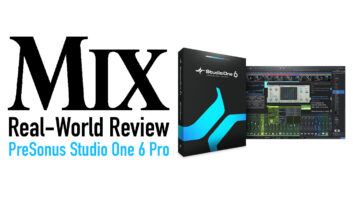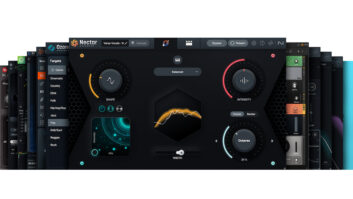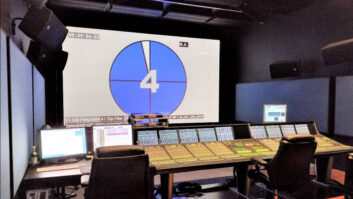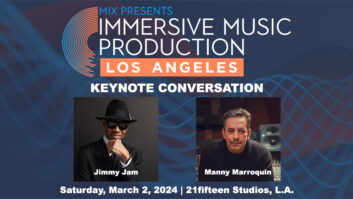Featuring IK Multimedia, Sonnox, Sound Toys, Tech 21, Universal Audio and Waves
We all know how important bass is to holding down that bottom end. And whether it’s a real bass guitar, synth bass or a combination of both, it’s critical to get that sound pumping. In this installment of PAR Picks 6 — our monthly, recommended software column — I detail six useful plug-ins to help dial in the most killer low end.
1 IK Multimedia Ampeg SVX Amp Modeling Plug-In
(Left) IK Multimedia Ampeg SVX Amp Modeling Plug-In; (Right) Sonnox Oxford Transient ModulatorAmpeg and IK Multimedia worked together to re-create a software version of one of the great bass amps of all time. The interface lets you choose from four amp models including the SVT-Classic, B-15R Portaflex Flip Top, BA-500 and SVT-4PRO. Cabinet choices include the B-15R, BA-500, BXT- 410H, PB212H, SVT-410H and SVT-810E, as well as a handful of microphone models and analog modeled stomp boxes. It can work as a standalone application or within your DAW as an AU, VST or RTAS plug-in.


My favorite combination is the B-15R fliptop head with B-15R cabinet, which delivers a thick, classic tone. It’s nice to have Gain for some overdrive and Bass, Mid and Treble frequency knobs to customize the sound to fit the mix. The SVT sounds especially delicious on my old 70 Fender P bass, but I’ve also used it to add beef to synth bass parts and even on miked-up bass tracks that sounded less than stellar. Note that you can also use the Mix knob to blend in the SVT signal with your original bass, offering the best of both worlds.
Price: $129.99
Contact: IK Multimedia | ikmultimedia.com/ampegsvx
2 Sonnox Oxford Transient Modulator (TransMod)
This one’s a little different. The Transient Modulator — or TransMod, for short — does just that: modulates transients, making your bass (or whatever you put through it) have either more or less note attack. It’s got only a few knobs and faders, so it’s super easy to use. Gain will boost or increase gain, Threshold sets the level at which the process will operate above, and Deadband can help control the processing of insignificant transients. Ratio can be set either positive or negative, whereas positive increases the attack and negative reduces it. Overshoot sets the time in which that processing occurs. So with a picked bass part for example, increasing the Ratio and Overshoot drives the pick sound. Decreasing it pulls it back and pushes the groove back in the pocket.
With the Overdrive at 100 percent, the process will include peak information up to 6 dB greater than max, without overloads, providing a nice harmonic fullness. RiseTime and Recovery are used to modify the timing and response of the envelope processing, but I don’t use them much. Overall, it’s a powerful effective tool for bass transient control.
Price: $115, $195 (Native only, TDM and Native, respectively)
Contact: Sonnox Plug-Ins | sonnoxplugins.com
3 Sound Toys Decapitator Analog Saturation Modeler
While yes, this has been in our Pick 6 before, it had to come up again when talking about bass. This analog saturation modeler can give bass tracks some nice beef and presence, without dramatically changing the natural bass sound.
Sound Toys Decapitator Analog Saturation ModelerMy most used button is the Tone knob, which is simply labeled Dark or Bright. With a quick twist, you can change the character of the bass to pull some top down or give it an edge. Then you can hit it with a little Drive, which increases gain and distortion. If you flip up the Auto-Gain switch, it will automatically turn down the output even when you increase the Drive. To take it over the top, press the Punish button, which drops an extra 20 dB of gain into your path. Watch out though, it can blast.

At the bottom of the plug-in are Style switches for five different saturation algorithms, including an Ampex 350 tape drive preamp, Chandler/EMI TG Channel, Neve 1057 (my favorite), Thermionic Culture Vulture triode and pentode setting. On my old Fender P bass, I use the Thump switch, which adds a few dB of low boost where the Low Cut control is set. This gives a nice, big bottom without the mudflaps. How can you go wrong with that?
Price: $179, $349 (Native and TDM, respectively)
Contact: Sound Toys | soundtoys.com
4 Avid Tech 21 SansAmp PSA-1
When I want distortion on a bass, this is the plug-in I turn to. In the factory presets, there’s a Bass folder with a few patches with names like Insane Bass and Extra Crunchy Bass. They are great places to start, or I have my own presets customized for different kinds of bass tones.
Avid Tech 21 SansAmp PSA-1What makes this one different from other distortion units is the “in your face” aggressive tone that cuts through tracks, even those with big distorted guitars. Cranking the Punch knob delivers the sound of speakers just breaking up. If you then turn up the Crunch and Drive knobs, it can get savage. The Preamp and Buzz knobs both add their own nasty touch, which can be dialed in as needed. I tend to actually cut the Low knob, as it can overwhelm the mix. If I do add bass back in, I will do it with a parametric EQ, allowing me finer control.

The PSA-1 is not just for distorted bass. It can help add just a touch of edge to any bass part, and on clean tracks, the Punch knob does the job. Can’t go wrong with this one.
Price: Included with Pro Tools
Contact: Avid | avid.com
5 Universal Audio Little Labs VOG (Voice Of God) Bass Resonance Tool
Ah, my newest favorite toy for bass sounds. It’s great because it’s not really an EQ, more like a filtering processor. Based on the 500-series hardware unit, VOG features only two knobs and three buttons.
Universal Audio Little Labs VOG Bass Resonance ToolThe Amplitube knob adjusts the amount of effect in the overall signal. While its range is 0-10, the numbers do not reflect a specific dB value. Increasing the level boosts the gain frequencies determined by the Frequency knob and two Center switches. The Frequency knob adjusts the actual target frequency of the effect. Frequencies above the setting are boosted and frequencies below are attenuated (by -24 dB per octave).

The two Center switches determine the active center frequency, with fixed choices of 40, 42, 100 and 200 Hz. The Flat button bypasses the EQ circuitry, and when it’s on (red LE D), the dry signal path of the hardware is still being modeled. For true bypass, you can use the Power switch.
I dig the fact that within a few seconds of tweaking, your bass simply sounds better. Also, the low-end cut helps keep the bottom tight and focused, helping to punch the bass through even the smallest speakers. It’s the kind of plug-in you need to experiment with — just twist to taste. But boy, does it taste good when you get it right.
Price: $149
Contact: Universal Audio | uaudio.com
6 Waves CLA-3A Compressor/Limiter
A great emulation of the classic ’70s (well, 1969) Universal Audio solid-state unit, this “audio leveler” uses an electro-optical attenuator for program-dependent compression. That basically means you don’t have to do any work to get a killer bass sound. Set the Gain and Peak Reduction and let it go.
Waves CLA-3A Compressor/LimiterThe CLA-3A delivers a classic, thick compression (approximately 3:1) to bass, but you can also set it to limit (at approximately 100:1 ratio). The Peak Reduction knob sets the amount of desired compression, and the Gain delivers makeup.

At the bottom of the plug-in sits the HiFreq, which increases the voltage amplifier gain in the peak-reduction circuit, leaving frequencies below 1 kHz unaffected. There are Analog buttons for controlling the noise floor and hum from the original power supplies, with a choice of 50 Hz, 60 Hz and Off.
Price: $150, $200 (Native and TDM, respectively)
Contact: Waves | waves.com







